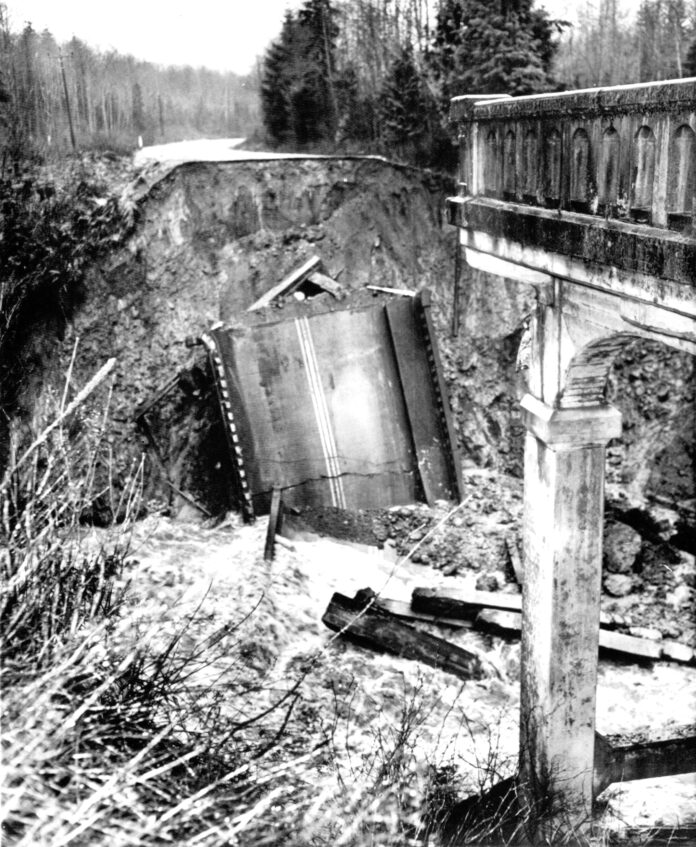Record-breaking rain events during the winter of 1964-65 caused widespread flooding up and down the West Coast. The upper White River basin experienced severe flooding during the third of three torrential rainstorms between December 19 and January 31. On Jan. 28, 1965, the Scatter Creek Bridge located six miles east of Enumclaw on Highway 410 collapsed during heavy flooding. The basin encompassed over 10 square miles and the cumulative rainfall crowded Scatter Creek’s narrow passage about a mile before it flows into the White River.
In addition, the Weyerhaeuser Company’s logging road bridge located parallel to and 50 feet downstream also toppled when torrents of debris first eroded and then undermined the pillars holding up the overpass. With Cayuse Pass blocked by snow slides, over 400 people were stranded at Crystal Mountain and the nearby Buck Creek Camp and Conference Center, then owned by the Seattle Presbyterians. Nearer to Enumclaw, Boise Creek washed out a stretch of Hwy. 410 and undermined power poles.
Howard Paulson, the manager of Crystal Mountain reported that 170 were trapped at the resort, including 75 guests, 30 who rent apartments, and 70 or so employees. So were those living in Greenwater, and surrounding cabins and vacation homes. Two Buck Creek cooks, Gretchen Alwine and Alice Fountain, both Enumclaw residents were similarly grounded. To rescue those stranded, six Air Force helicopters ferried the skiers and others to Enumclaw on Saturday, Jan. 30. The twin-rotor, jet-powered, Husky helicopters dodged clouds and butted 50-knot winds while rain and sleet pounded their windshields. They carried five to six persons per shuttle trip with skis and luggage left behind. Some of those flown out were high school students taking advantage of a brief skiing holiday before semesters.
That same day, millions of Americans watched hours of live coverage on ABC, CBS, and NBC television station broadcasts during the state funeral of Winston Churchill. The U.S. audience was larger than President Kennedy’s funeral 14 months earlier.
State highway officials quickly develop plans for a temporary span over Scatter Creek and reopening Cayuse Pass from the opposite direction. Paul McKay, the district’s highway engineer announced plans to utilize part of a vacated county road where an interim detour could more easily cross the Scatter Creek ravine. The site was 450 upstream where a portable, pre-fabricated, truss called a Bailey bridge was chosen for the temporary crossing. Construction of a new multi-span bridge crossing for SR 410 would take months to complete. The Bailey bridge was developed by the British military for use during the Second World War and saw extensive use by British, Canadian, and American engineering units.
To allow workers access to both sides of the stream, the first link across Scatter Creek was a three-foot diameter, moss-covered tree felled by state crews with a hand rope for stability. The Bailey bridge was assembled on the Enumclaw bank with each of the 10-foot long, five-foot high panels pushed atop rollers towards the east bank. A 90-foot ‘nose’ preceded the bridge panels to provide balance on each side of a pivot point built on the west edge of the creek, something like a teeter-totter.
Wood planking was placed for the roadway. Sixteen men from the Seattle and Tacoma state highway districts worked 12-hour days for over a week to make the crossing. Art Knoll, a Tacoma foreman credited four men from his crew who gained experience assembling this type of bridge during World War II. The finished 12-foot wide bridge weighed 100 tons and consisted of one lane with traffic lights at the bridge and one further east at Clay Creek.
The new Scatter Creek Bridge at milepost 31 was completed several months later. Repairs in the summer of 2014 seismically retrofit the two supporting columns by placing steel jackets around the bridge piers to reduce the risk of collapse in the event of an earthquake. During its last inspection in May 2022, the bridge was evaluated and found to exceed the minimum standard. Today it supports about 2,200 vehicle trips per day, of which 8% or 175 are trucks. The bridge is of critical importance as there are no alternative routes during the winter when SR 410 closes each year due to excessive snow on Cayuse Pass.
This photo by Richard S. Heyza appeared on the front page of the Jan. 29, 1965, Seattle Times and comes courtesy of JoAnne Matsumura who also provided a number of newspaper articles about the bridge collapse, evacuation, and repairs. Matsumura is an Issaquah historian, researcher, and collector of vintage photos.







